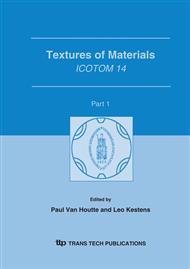p.1219
p.1225
p.1231
p.1237
p.1243
p.1249
p.1255
p.1261
p.1267
Effect of Stacking Fault Energy on Evolution of Recrystallization Textures in Drawn Wires and Rolled Sheets
Abstract:
The drawing textures of aluminum, copper, gold, silver, and Cu-7.3% Al bronze wires are approximated by major <111>+minor <100>, except silver wire, which can have the <100> texture at extremely high reductions. The <111> component in the drawing textures of aluminum, copper, gold, and silver transform to the <100> component after recrystallization. On the other hand, the <111> deformation texture of the Cu-7.3% Al bronze wire, which has very low stackingfault- energy, remains unchanged after recrystallization. The Brass component {110}<112> in rolling textures of high stacking-fault-energy metals such as aluminum and copper alloys changes to the Goss orientation {110}<001> after recrystallization. However, the Brass orientation in rolling textures of low stacking-fault-energy fcc metals such as brass appears to change to the {236}<385> orientation after recrystallization. These results seem to be related to the stability of dislocations during annealing.
Info:
Periodical:
Pages:
1243-1248
Citation:
Online since:
September 2005
Authors:
Keywords:
Price:
Сopyright:
© 2005 Trans Tech Publications Ltd. All Rights Reserved
Share:
Citation:


